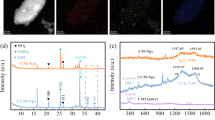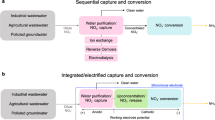Abstract
Livestock manure wastewater, containing high level of ammonia, is a major source of water contamination, posing serious threats to aquatic ecosystems. Because ammonia is an important nitrogen fertilizer, efficiently recovering ammonia from manure wastewater would have multiple sustainability gains from both the pollution control and the resource recovery perspectives. Here we develop an electrochemical strategy to achieve this goal by using an ion-selective potassium nickel hexacyanoferrate (KNiHCF) electrode as a mediator. The KNiHCF electrode spontaneously oxidizes organic matter and uptakes ammonium ions (NH4+) and potassium ions (K+) in manure wastewater with a nutrient selectivity of ∼100%. Subsequently, nitrogen- and potassium-rich fertilizers are produced alongside the electrosynthesis of H2 (green fuel) or H2O2 (disinfectant) while regenerating the KNiHCF electrode. The preliminary techno-economic analysis indicates that the proposed strategy has notable economic potential and environmental benefits. This work provides a powerful strategy for efficient nutrient (NH4+ and K+) recovery and decentralized fertilizer and chemical production from manure wastewater, paving the way to sustainable agriculture.
This is a preview of subscription content, access via your institution
Access options
Access Nature and 54 other Nature Portfolio journals
Get Nature+, our best-value online-access subscription
$29.99 / 30 days
cancel any time
Subscribe to this journal
Receive 12 digital issues and online access to articles
$119.00 per year
only $9.92 per issue
Buy this article
- Purchase on Springer Link
- Instant access to full article PDF
Prices may be subject to local taxes which are calculated during checkout






Similar content being viewed by others
Data availability
The data that support the findings of this study are available from https://datadryad.org/stash/share/cFZs-SiOoCr9vc0Bket78q_6o33JBEuo9Qb_IOT3f30. Source data are provided with this paper.
References
Johnson, B. J. & Fuerniss, L. 114 What Is the impact of dairy influence cattle on the traditional beef industry structure? J. Anim. Sci. 99, 38–39 (2021).
Lemaire, G., Franzluebbers, A., Carvalho, P. C. d. F. & Dedieu, B. Integrated crop–livestock systems: strategies to achieve synergy between agricultural production and environmental quality. Agric. Ecosyst. Environ. 190, 4–8 (2014).
Factory Farm Nation: 2020 Edition (Food and Water Watch, 2020); https://www.foodandwaterwatch.org/insight/factory-farm-nation-2020-edition
Horn, H. H. V., Wilkie, A. C., Powers, W. J. & Nordstedt, R. A. Components of dairy manure management systems. J. Dairy Sci. 77, 2008–2030 (1994).
Guidelines for Water Reuse (US EPA, 2004).
IPCC Climate Change 2007: Synthesis Report (eds Bernstein, L. et al.) (IPCC, 2008).
Mosier, A. et al. Closing the global N2O budget: nitrous oxide emissions through the agricultural nitrogen cycle. Nutr. Cycling Agroecosyst. 52, 225–248 (1998).
Böhlke, J., Wanty, R., Tuttle, M., Delin, G. & Landon, M. Denitrification in the recharge area and discharge area of a transient agricultural nitrate plume in a glacial outwash sand aquifer, Minnesota. Water Resour. Res. 38, 10-1–10-26 (2002).
Burton C. H. & Turner C. Manure Management: Treatment Strategies for Sustainable Agriculture Editions Quae (Silsoe Research Institute, 2003).
Oenema, O., Oudendag, D. & Velthof, G. L. Nutrient losses from manure management in the European Union. Livest. Sci. 112, 261–272 (2007).
Aguirre-Villegas, H. A. & Larson, R. A. Evaluating greenhouse gas emissions from dairy manure management practices using survey data and lifecycle tools. J. Clean. Prod. 143, 169–179 (2017).
Fang, C. et al. Energy and nutrient recovery from sewage sludge and manure via anaerobic digestion with hydrothermal pretreatment. Environ. Sci. Technol. 54, 1147–1156 (2019).
Pandey, B. & Chen, L. Technologies to recover nitrogen from livestock manure—a review. Sci. Total Environ. 784, 147098 (2021).
Tarpeh, W. A. & Chen, X. Making wastewater obsolete: selective separations to enable circular water treatment. Environ. Sci. Ecotechnol. 5, 100078 (2021).
Sun, M. et al. Electrochemical–osmotic process for simultaneous recovery of electric energy, water, and metals from wastewater. Environ. Sci. Technol. 54, 8430–8442 (2020).
Qin, M. & He, Z. Self-supplied ammonium bicarbonate draw solute for achieving wastewater treatment and recovery in a microbial electrolysis cell-forward osmosis-coupled system. Environ. Sci. Tech. Let. 1, 437–441 (2014).
Kuntke, P. et al. Ammonium recovery and energy production from urine by a microbial fuel cell. Water Res. 46, 2627–2636 (2012).
Qin, M., Molitor, H., Brazil, B., Novak, J. T. & He, Z. Recovery of nitrogen and water from landfill leachate by a microbial electrolysis cell-forward osmosis system. Bioresour. Technol. 200, 485–492 (2016).
Tarpeh, W. A., Barazesh, J. M., Cath, T. Y. & Nelson, K. L. Electrochemical stripping to recover nitrogen from source-separated urine. Environ. Sci. Technol. 52, 1453–1460 (2018).
Li, Y. et al. Bipolar membrane electrodialysis for ammonia recovery from synthetic urine: experiments, modeling, and performance analysis. Environ. Sci. Technol. 55, 14886–14896 (2021).
Yang, K. & Qin, M. The application of cation exchange membranes in electrochemical systems for ammonia recovery from wastewater. Membranes 11, 494 (2021).
Kuntke, P. et al. Hydrogen gas recycling for energy efficient ammonia recovery in electrochemical systems. Environ. Sci. Technol. 51, 3110–3116 (2017).
Gao, R., Bonin, L., Arroyo, J. M. C., Logan, B. E. & Rabaey, K. Separation and recovery of ammonium from industrial wastewater containing methanol using copper hexacyanoferrate (CuHCF) electrodes. Water Res. 188, 116532 (2021).
Kim, T., Gorski, C. A. & Logan, B. E. Ammonium removal from domestic wastewater using selective battery electrodes. Environ. Sci. Tech. Let. 5, 578–583 (2018).
Son, M. et al. Stepwise ammonium enrichment using selective battery electrodes. Environ. Sci. Water Res. Technol. 6, 1649–1657 (2020).
Jang, Y., Hou, C.-H., Kwon, K., Kang, J. S. & Chung, E. Selective recovery of lithium and ammonium from spent lithium-ion batteries using intercalation electrodes. Chemosphere 317, 137865 (2023).
Porada, S., Shrivastava, A., Bukowska, P., Biesheuvel, P. M. & Smith, K. C. Nickel hexacyanoferrate electrodes for continuous cation intercalation desalination of brackish water. Electrochim. Acta 255, 369–378 (2017).
Wang, F. et al. Modular electrochemical synthesis using a redox reservoir paired with independent half-reactions. Joule 5, 149–165 (2021).
Chen, L., Dong, X., Wang, Y. & Xia, Y. Separating hydrogen and oxygen evolution in alkaline water electrolysis using nickel hydroxide. Nat. Commun. 7, 11741 (2016).
Landman, A. et al. Photoelectrochemical water splitting in separate oxygen and hydrogen cells. Nat. Mater. 16, 646–651 (2017).
Symes, M. D. & Cronin, L. Decoupling hydrogen and oxygen evolution during electrolytic water splitting using an electron-coupled-proton buffer. Nat. Chem. 5, 403–409 (2013).
Wang, R. et al. Sustainable coproduction of two disinfectants via hydroxide-balanced modular electrochemical synthesis using a redox reservoir. ACS Cent. Sci. 7, 2083–2091 (2021).
Michael, K. H. et al. Pairing of aqueous and nonaqueous electrosynthetic reactions enabled by a redox reservoir electrode. J. Am. Chem. Soc. 144, 22641–22650 (2022).
Liang, G., Mo, F., Ji, X. & Zhi, C. Non-metallic charge carriers for aqueous batteries. Nat. Rev. Mater. 6, 109–123 (2020).
Chao, D. et al. Roadmap for advanced aqueous batteries: from design of materials to applications. Sci. Adv. 6, eaba4098 (2020).
Rassat, S. D., Sukamto, J. H., Orth, R. J., Lilga, M. A. & Hallen, R. T. Development of an electrically switched ion exchange process for selective ion separations. Sep. Purif. Technol. 15, 207–222 (1999).
Dong, S. et al. Ultra-fast NH4+ storage: strong H bonding between NH4+ and bi-layered V2O5. Chem 5, 1537–1551 (2019).
Liang, G. et al. Initiating hexagonal MoO3 for superb-stable and fast NH4+ storage based on hydrogen bond chemistry. Adv. Mater. 32, 1907802 (2020).
Wessells, C. D., Peddada, S. V., Huggins, R. A. & Cui, Y. Nickel hexacyanoferrate Nnanoparticle electrodes for aqueous sodium and potassium ion batteries. Nano Lett. 11, 5421–5425 (2011).
Wu, X. et al. Rocking-chair ammonium-ion battery: a highly reversible aqueous energy storage system. Angew. Chem. Int. Ed. 56, 13026–13030 (2017).
Shi, L. et al. Metal-ion depletion impacts the stability and performance of battery electrode deionization over multiple cycles. Environ. Sci. Technol. 55, 5412–5421 (2021).
Liu, C. et al. Lithium extraction from seawater through pulsed electrochemical intercalation. Joule 4, 1459–1469 (2020).
Qin, M., Liu, Y., Luo, S., Qiao, R. & He, Z. Integrated experimental and modeling evaluation of energy consumption for ammonia recovery in bioelectrochemical systems. Chem. Eng. J. 327, 924–931 (2017).
Sheng, H., Ross, R. D., Schmidt, J. R. & Jin, S. Metal-compound-based electrocatalysts for hydrogen peroxide electrosynthesis and the electro-Fenton process. ACS Energy Lett. 8, 196–212 (2022).
Yang, S. et al. Toward the decentralized electrochemical production of H2O2: a focus on the catalysis. ACS Catal. 8, 4064–4081 (2018).
Jiang, K. et al. Highly selective oxygen reduction to hydrogen peroxide on transition metal single atom coordination. Nat. Commun. 10, 3997 (2019).
Raven, J. A. Chloride: essential micronutrient and multifunctional beneficial ion. J. Exp. Bot. 68, 359–367 (2017).
Wu, X. et al. Diffusion-free Grotthuss topochemistry for high-rate and long-life proton batteries. Nat. Energy 4, 123–130 (2019).
Acknowledgements
This research is supported by the National Science Foundation (NSF, CBET- 2219089). We acknowledge the facilities and instrumentation at the UW–Madison Wisconsin Centers for Nanoscale Technology (wcnt.wisc.edu), partially supported by the NSF through the University of Wisconsin Materials Research Science and Engineering Center (number DMR-1720415). We thank J. Lazarcik for help with access to the IC and ICP-OES instruments supported by the Water Science and Engineering Laboratory at UW–Madison. We thank X. Zou for help with the graphic design of Fig. 1.
Author information
Authors and Affiliations
Contributions
R.W. and S.J. designed the experiments. R.W. carried out materials synthesis, materials characterization, electrochemical measurements, ammonium recovery and electrochemical production measurements and analysis of manure wastewater with the help of K.Y. K.Y. and M.Q. prepared manure wastewater. C.W. and F.B. conducted the techno-economic analysis. H.A.-V. and R.L. modelled the ammonia emissions reductions. M.Q. and S.J. supervised the project. R.W., M.Q. and S.J. wrote the paper, and all the authors commented on it.
Corresponding authors
Ethics declarations
Competing interests
A provisional patent based on this work has been filed by R.W. and S.J. The other authors declare no competing interests.
Peer review
Peer review information
Nature Sustainability thanks Taeyoung Kim, Philipp Kuntke and Zhiguo Yuan for their contribution to the peer review of this work.
Additional information
Publisher’s note Springer Nature remains neutral with regard to jurisdictional claims in published maps and institutional affiliations.
Supplementary information
Supplementary Information
Supplementary Methods, Figs. 1–52, Tables 1–16 and Notes 1–6.
Source data
Source Data Fig. 2
Electrochemical results.
Source Data Fig. 3
Electrochemical results and production detections.
Source Data Fig. 4
Electrochemical results and production detections.
Source Data Fig. 5
Electrochemical results and production detections.
Source Data Fig. 6
Analysis.
Rights and permissions
Springer Nature or its licensor (e.g. a society or other partner) holds exclusive rights to this article under a publishing agreement with the author(s) or other rightsholder(s); author self-archiving of the accepted manuscript version of this article is solely governed by the terms of such publishing agreement and applicable law.
About this article
Cite this article
Wang, R., Yang, K., Wong, C. et al. Electrochemical ammonia recovery and co-production of chemicals from manure wastewater. Nat Sustain 7, 179–190 (2024). https://doi.org/10.1038/s41893-023-01252-z
Received:
Accepted:
Published:
Issue Date:
DOI: https://doi.org/10.1038/s41893-023-01252-z



